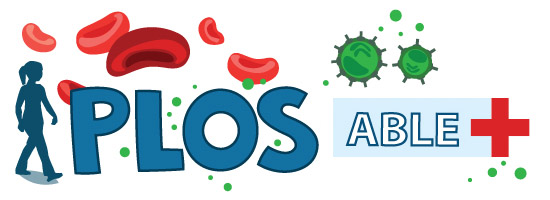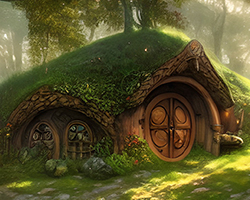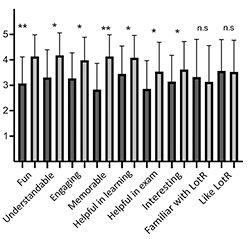
Learning Science With the Hobbits
Learning biology can be a lot like learning a new language. There are unique words and terms that can make it difficult to learn or to teach. For those just learning biology, some of the words (like dendrite, or foramen) may as well be from a fictional language. But what if that—fiction—is something that could help with learning complex ideas?

Could fiction or fantasy stories with hobbits help students figure out difficult science topics?
In the article “The Life History Theory of the Lord of the Rings: A Randomized Controlled Trial of Using Fact Versus Fiction to Teach Life History Theory”, scientists tested if using Tolkien’s Lord of the Rings stories helped students learn about a complex topic in biology.
What Is Life History Theory?
If we compare an elephant and a mouse, we’d find they have a lot of differences. One is very big while the other is very small. One lives several decades while the other lives a few years. The diversity of life and the ways species survive and reproduce can be explained by the theory of life history.

Some animals live long, reproduce slowly, and invest a lot in growth. These animals have a slow life history strategy. They might have lived in a stable environment with few predators.
On the other hand, animals that lived in a changing environment or one with a lot of predators might have a fast strategy. These animals might be smaller, have lots of young, and not put a lot of energy into raising them.
Easy to remember…yeah? Well… maybe not. But, if this seems like a difficult topic, let’s talk about it in a different way. Let’s compare these life strategies to those of the human-like characters in The Lord of the Rings.
The Lord of the Rings Life Histories
We can sort the characters of The Lord of the Rings by their life history strategy, from slowest to fastest.

Elves take 50-100 years to reach adult life. Apparently, they never die. They are not prone to many diseases and are great at healing wounds. Not dying is not possible of course. But we might infer that Tolkien meant that their biological functions do not become worse with age. With just a few children, and long gaps between births, it is no wonder that they have so much time to invest in each child as well as their own body maintenance.
Next, we see the dwarves. At 30 years of age they reach adult life, but they usually don't have babies until after their 90s. Sometimes they live up to 250 years, but not as long as elves. Can they cope as well as elves with wounds and diseases? Dwarves deal well with diseases and most kinds of damage if we compare them to other human-like characters of Middle-Earth. Still, they are prone to obesity.

Halflings, or as they like to be called, 'hobbits', are similar in life history strategy to humans. Hobbits live around 100 years, but unlike humans, they are not prone to violence or war with each other. They die of very few external factors.
Orcs, also known as demons in old English, are small creatures. They can be attacked by other human-like characters of Middle-Earth and other orcs. They have many babies that probably live just a few years. This is partly due to their many external causes of death. These traits show that orcs have the fastest life history strategy out of all the human-like characters in The Lord of the Rings.
Learning Science vs. Fiction
Scientists had a question: does reading a fictional article versus a biological article on life history theory help students perform better in a life history theory exam? The scientists began an experiment with two groups of 132 students. All these were students in an evolution course at Arizona State University.
Scientists asked one group to read a biology-only article on life history theory that the scientists had used in previous years. They asked the other group to read an article on life history evolution with human-like characters from The Lord of the Rings (LOTR). The scientists then noted the students’ scores on a life-history exam. They also asked the students to answer a survey about their reading experience.
Does LOTR Help With Learning Biology?
Yes, in certain ways. The ‘fiction’ group noted that the LOTR article was better than the biology-only life history article. Students liked the fiction-based article in seven different ways.

The ‘fiction’ article was more fun and it was easier to understand. It was also more interesting, more engaging, and easier to remember. The students felt this made it more helpful in learning the theory of life history. They also thought it was more helpful in answering the life history questions on the exam. Both groups did equally well on the exam questions.
In addition, scientists compared students who like The Lord of the Rings to those that don’t. They found that the first group had higher scores on their life-history exam questions. The first group also reported feeling more joy, engagement, and interest in learning life history theory. The same group also found that the fictional article helped them more to prepare for and answer the life history questions in the exam.
Inclusive Learning
These results tell us that using fictional stories, such as The Lord of the Rings, can be great for learning the biology of life history theory. “All we have to decide is what to do with the time that is given to us,” says Gandalf. We encourage you to try to apply storylines that move you to whatever you’re learning. This can help increase your creativity, enjoyment, and mastery of science. Especially when dealing with biology, it just may help you learn something important.
Bibliographic details:
- Article: Learning Science With the Hobbits
- Author(s): Sareh Seyedi, Stefania E. Kapsetaki, Carlo C. Maley
- Publisher: Arizona State University School of Life Sciences Ask A Biologist
- Site name: ASU - Ask A Biologist
- Date published:
- Date accessed:
- Link: https://askabiologist.asu.edu/plosable/LOTR-life-history-theory
APA Style
Sareh Seyedi, Stefania E. Kapsetaki, Carlo C. Maley. (). Learning Science With the Hobbits. ASU - Ask A Biologist. Retrieved from https://askabiologist.asu.edu/plosable/LOTR-life-history-theory
Chicago Manual of Style
Sareh Seyedi, Stefania E. Kapsetaki, Carlo C. Maley. "Learning Science With the Hobbits". ASU - Ask A Biologist. . https://askabiologist.asu.edu/plosable/LOTR-life-history-theory
Sareh Seyedi, Stefania E. Kapsetaki, Carlo C. Maley. "Learning Science With the Hobbits". ASU - Ask A Biologist. . ASU - Ask A Biologist, Web. https://askabiologist.asu.edu/plosable/LOTR-life-history-theory
MLA 2017 Style

Be Part of
Ask A Biologist
By volunteering, or simply sending us feedback on the site. Scientists, teachers, writers, illustrators, and translators are all important to the program. If you are interested in helping with the website we have a Volunteers page to get the process started.
